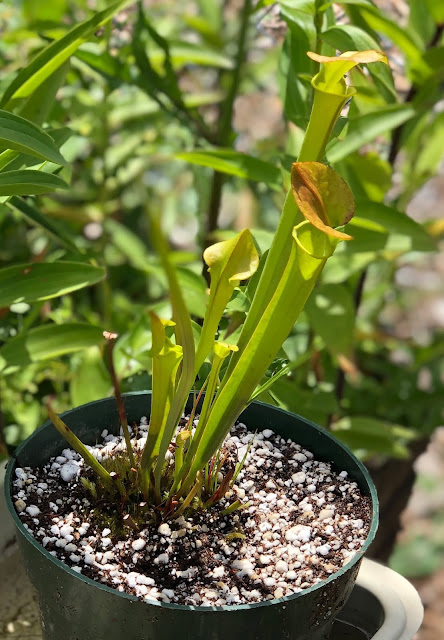Showing posts with label Venus Flytrap. Show all posts
Showing posts with label Venus Flytrap. Show all posts
Saturday, June 12, 2021
Carnivorous Plant Update. 6.12.2021
These aare the hardy, perennial carnivores, pitcher plants and a Venus flytrap. They live in 50:50 mix of perlite and peat moss, with the pots in about an inch of water all of the time. I change the water daily or every other day to eliminate mosquitoes. This has worked nicely for several years, and grown out of two sets of repotting. So Imrepotted them yesterday.
This is the most the pitcher plants (Sarracenia) have bloomed. Very lovely and unique flowers.
Tuesday, April 23, 2019
Carnivorous Plant Updates. 4.23.19
 |
| Nepenthes sanginea. 4.23.19 |
 |
| Nepenthes sanginea. 4.23.19 |
 |
| Emerging Pitchers and Flower Bud on Sarracenia "Extreme Green". 4.23.19 |
 |
| Emerging Flower Stalk on Sarraenia "Tarnok". 4..23.19 |
 |
| Emerging Traps on Venus Flytrap. 4.23.19 |
Labels:
Carnivorous plants,
nepenthes,
Sarracenia,
Venus Flytrap
Monday, June 04, 2018
Carnivorous Plants. 6.4.18
 |
| Venus Flytrap |
The Venus Flytrap is highly magnified. It's only a couple of inches across.
They've all been catching flies and yellow jackets.
I've been following Jacob's instructions, in his ebook. so far, with these plants, that means mainly they re in a shallow container with about an inch of low mineral (rain) water, and are in full sun, on the deck.
 |
| Sarracenia purpurea, I think. It was unlabeled. |
 |
| A Sarracenia hybrid. |
 |
| More Sarracenia hybrids. |
 |
| The large one is Sarracenia oreophilia, I think. |
Labels:
Carnivorous plants,
Sarracenia,
Venus Flytrap
Friday, March 16, 2018
Venus Flytrap. Cool Stuff.
This is an experiment to see if I can embed videos. This one is from Youtube, not something I filmed or grew. It shows a Venus Flytrap eating a fly. These plants have their own kind of nerve-like responses, and grab their prey after a specific number of movements. I couldn't figure out how to embed this even cooler video from NY times, but here is a link. Scienceline describes how the plants create electrical impulses from their trigger hairs, that serve as mechanosensors, back to the mechanical energy to snap shut around their prey. The scienceline link also shows a Venus flytrap catching a small frog.
Inspired by my friend Jacob Farin at the carnivorous plant nursery, Sarracenia NW, I've started a new carnivorous plant blog "Beautiful Carnivorous Plants" also on the blogspot platform.
Labels:
Carnivorous plants,
Drosera,
Venus Flytrap
Subscribe to:
Comments (Atom)






